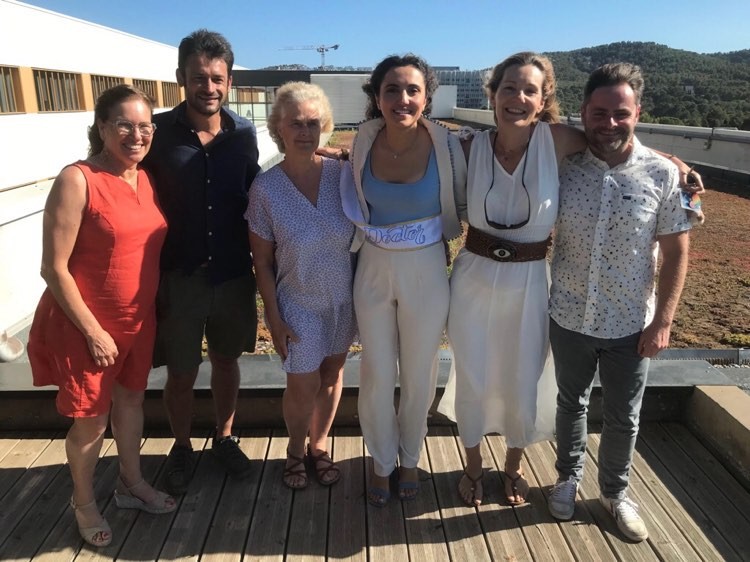On the following subject: The role of diazotrophs in the biological carbon pump: study of aggregation, export and remineralisation processes

Composition of the jury
Jury
Director of these Ms Sophie BONNET Aix-Marseille université
Rapporteur Ms Ilana BERMAN-FRANK University of Haifa, ISRAEL
Rapporteur Ms Camila FERNANDEZ Sorbonne université. Microbial Oceanography Laboratory (LOMIC) - UMR 7621 CNRS-UPMC
Co-Director of these Mr Frédéric A. C. LE MOIGNE University of Brest. LEMAR, Marine Environment Sciences Laboratory, UMR6539, CNRS, UBO, IFREMER, IRD, Plouzané, Technopôle Brest-Iroise, France
Examiner Mr Matthieu BRESSAC Laboratoire d'Océanographie de Villefranche, LOV. UMR7093
Examiner Ms France VAN-WAMBEKE Aix Marseille université. Mediterranean Institute of Oceanography (MIO).
Guest Thierry MOUTIN Aix Marseille university. Mediterranean Institute of Oceanography (MIO)
Summary of the thesis
In nitrogen-depleted (sub)tropical oceans occupying ~60% of the global ocean surface, diazotrophs support >50% of new primary production through the fixation of atmospheric nitrogen (N2). This thesis studies the fate of diazotrophs in the ocean, and in particular the processes of aggregation, export and remineralisation, in order to assess their potential role in the biological carbon pump (PCB). The objectives of this thesis were: 1) To study the aggregation and export mechanisms of physically, morphologically and physiologically contrasting diazotrophs. 2) To measure the remineralisation rates of the most widespread diazotroph in (sub)tropical oceans (Trichodesmium) as it falls into the deep ocean. 3) To identify the composition of the flux of particulate organic carbon (POC) exported to an N2 fixation hotspot and to determine the contribution of diazotrophs to this flux. (1) An experiment simulating the fall of diazotrophs in roller tanks was used to measure the aggregation rates and fall speeds of four types of diazotrophs with contrasting sizes (1-1000 µm), morphologies (filamentous vs. unicellular) and physiologies (production of exopolymeric substances, TEP). This study showed that all diazotrophs independently of their size, shape and physiology formed aggregates of sizes 7000-32014 μm and fell at speeds of 92 to >400 m d-1 . Unicellular diazotrophs achieved fall rates comparable to filamentous diazotrophs due to their ability to form aggregates in the same size range. In contrast, the PETs produced by the diazotrophs did not increase their aggregation capacity or their falling speeds, suggesting that their chemical properties may also play an important role in these processes. (2) In a second study in roller tanks, we simulated the fall of Trichodesmium to a depth of 1000 m, in the presence of a natural consortium of heterotrophic bacteria. This study showed that 42% of its derived biomass was still present at the end of the experiment, suggesting incomplete bacterial remineralisation and potential sequestration of this biomass in the deep ocean. (3) A third field study carried out in the tropical south-west Pacific during the TONGA oceanography expedition identified and classified the particles exported to the deep ocean. By processing images of the particles, five categories were identified: faecal aggregates, phytodetritus and mixed aggregates, cylindrical faecal pellets and zooplankton carcasses. Faecal aggregates were the most abundant, dominating the POC flux with an average of 56±28% of the total POC flux. Zooplankton carcasses were also abundant and contributed 24±19% to the total POC flux, while cylindrical faecal pellets and mixed aggregates contributed 15±14% and 5±4% respectively. In contrast, phytodetritic aggregates were very low in abundance and contributed <1% to the total POC flux. Estimates of the export and transfer efficiencies of all particles combined were significant at 1000 m, showing the region's capacity to effectively sequester POC. In addition, image analyses obtained by confocal microscopy revealed that the contribution of diazotrophs to POC flux increased from 7% at 170 m to 51% at 1000 m, highlighting the direct export pathways of diazotrophs to the deep ocean and their role in PCBs. It is therefore becoming urgent to integrate these pathways into biogeochemical models in order to improve our understanding of their role in PCBs in today's ocean and tomorrow's, which will be warmer, more stratified and therefore more favourable to diazotrophy.




